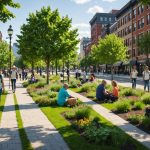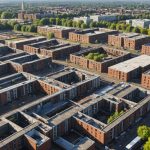The Importance of Public Green Spaces in Urban Environments
Nestled within the bustling urban landscapes, public green spaces offer much more than just a patch of nature amidst concrete and steel. These green havens play a vital role in fostering community engagement by providing a welcoming environment for social interactions and community building. Whether it’s children playing, families picnicking, or individuals walking their dogs, green spaces encourage people to connect, enhancing our social fabric.
Public green spaces also contribute significantly to mental health and physical well-being. They offer a sanctuary where one can unwind, reducing stress levels and promoting relaxation. Engaging with nature has been linked to improved mood and cognitive function, making these areas essential for mental health. Furthermore, parks and green areas encourage physical activity, offering spaces for walking, jogging, or cycling, which are crucial for maintaining health in urban settings.
In parallel : Maximizing returns: key investment strategies for capitalizing on uk industrial areas with declining markets
These spaces offer more than just aesthetic beauty—they contribute to the ecological health of urban landscapes by improving air quality, supporting biodiversity, and reducing urban heat. As such, public green spaces are indispensable in making cities more livable and resilient, meeting the needs of communities and the environment.
Case Studies of Successful Urban Green Space Initiatives
Urban greenery has the potential to transform cities while enhancing community engagement and local economies. Three noteworthy case studies exemplify this transition:
Also to read : Exploring the Financial Advantages of Transforming Commercial Real Estate into Co-Working Spaces in Manchester
New York City’s High Line
In New York, the High Line stands as a testimonial to successful urban green initiatives. Once an elevated railway line, it is now a thriving public park that blends innovative design with ecological awareness. Community input played a pivotal role in its transformation, fostering inclusivity. The local economy has flourished, thanks to increased tourism and business opportunities in the surrounding areas.
Milan’s Vertical Forest
Milan’s Vertical Forest is a groundbreaking architectural project addressing urban greenery through vertical spaces. The twin towers are home to over 900 trees, significantly improving air quality and biodiversity. This initiative not only promotes sustainability but also enhances the well-being of residents. It showcases how urban planning can creatively integrate nature into densely populated areas.
Seoul’s Cheonggyecheon Stream Restoration
Seoul’s Cheonggyecheon Stream Restoration exemplifies urban revitalisation by converting a highway into a green oasis. This initiative has bolstered community engagement and social cohesion, offering a serene environment in the bustling city. It underscores the potential for green space to reinvigorate urban landscapes, with lessons in public involvement and ecological design providing inspiration for future projects.
Designing Inclusive and Accessible Urban Parks
The creation of inclusive and accessible urban parks is essential for fostering community engagement and ensuring all residents can benefit. A key aspect is community input, which plays a fundamental role in park planning. Engaging local communities from the early stages ensures parks meet diverse needs, reflecting the unique characteristics and preferences of each neighborhood.
Inclusive design features should cater to all abilities and ages. Parks can incorporate elements such as level pathways, sensory gardens, and interactive art installations to welcome everyone. Accessibility standards must be rigorously applied, addressing physical barriers that prevent individuals with mobility challenges from enjoying these spaces.
Successful examples of inclusive design initiatives can be seen across the globe. These projects highlight best practices, such as incorporating universal design principles that proactively remove accessibility obstacles. For example, enhanced signage, tactile pathways, and rest areas create a welcoming environment for the elderly and those with disabilities.
Implementing strategies to ensure urban parks are truly inclusive fosters a culture of respect and acceptance, enhancing social cohesion and community pride. By prioritizing accessibility, urban planners can ensure that these green havens serve as a unifying force, enriching the lives of all city dwellers.
Benefits of Green Spaces on Community Well-being
The presence of green spaces in urban landscapes significantly enhances community well-being. They encourage physical activity, providing spaces where individuals can engage in walking, jogging, or cycling. Such activities are crucial for maintaining physical health, particularly in densely populated urban areas. Additionally, these spaces help reduce urban heat through natural cooling effects, which alleviate the heat island phenomenon prevalent in cities.
Moreover, the environmental benefits extend to improving air quality and supporting biodiversity, contributing to healthier urban settings. Green spaces are vital for fostering social ties, offering communal areas that strengthen social cohesion and neighborhood identity. Families, friends, and neighbours gather in these havens, promoting community engagement and interaction.
Social events, outdoor activities, and shared green experiences can bolster emotional bonds, fortifying a sense of belonging among city dwellers. Consequently, urban green spaces are more than just aesthetic features; they are integral to building socially cohesive and environmentally resilient cities. By nurturing these spaces, cities not only uplift community spirits but also create healthier environments conducive to living and thriving. Therefore, public investment in green spaces is an essential strategy for enhancing the overall quality of urban life.
Expert Opinions on the Role of Green Spaces
Insights from experts in urban planning reveal the transformative impact of public green spaces on community development. Renowned urban planners and landscape architects emphasize the role of these spaces in fostering vibrant communities. They point out that well-designed parks and green areas contribute to the social and economic fabric of cities, enhancing the quality of urban life.
Experts highlight that integrating green spaces into urban planning results in economic development by attracting tourism and boosting local businesses. Similarly, urban greenery enhances property values and encourages investment in surrounding areas. These benefits are particularly crucial for economically revitalizing neighborhoods, providing a tangible return on investment for municipalities.
Furthermore, professional recommendations for future projects focus on incorporating community input during the planning phase. Experts stress the importance of tailoring green spaces to the specific needs and characteristics of local populations. This approach not only ensures accessibility and inclusivity but also strengthens social ties, promoting a sense of ownership among residents.
In conclusion, expert insights advocate for the strategic integration of green spaces in urban environments. Such endeavors can lead to sustainable community growth, forging strong neighborhood identities and fostering long-lasting community engagement.
Funding and Maintaining Urban Green Spaces
The sustainability of urban green spaces hinges on effective funding strategies and maintenance practices. Government funding opportunities are pivotal, offering resources essential for the creation and preservation of these communal havens. Local municipalities can seek grants and subsidies specifically allocated for urban greenery projects, which support initial development and ongoing care.
In addition to government support, community fundraising and support initiatives constitute vital sources of funding. Community-driven efforts, such as local donations, events, and partnership programs with businesses, can significantly boost financial resources. These initiatives also foster a sense of ownership among residents, strengthening their commitment to the spaces they cherish.
Long-term maintenance strategies are indispensable for the longevity of urban green spaces. Routine care, including landscaping, waste management, and equipment repairs, should be systematically scheduled to ensure spaces remain welcoming and safe. Employing technology, like smart irrigation systems, can enhance efficiency and reduce costs.
Encouraging community stewardship ensures that urban parks remain vibrant and well-maintained. Residents can engage through volunteer programs and citizen advisory boards, providing hands-on support and valuable feedback. This symbiotic relationship between funding, maintenance, and community engagement ensures the sustainable success of urban green spaces.











